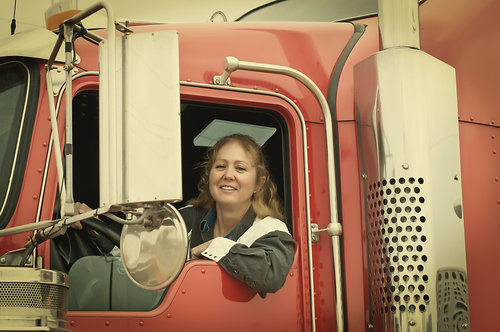
(PHOTO: SHUTTERSTOCK)
Between new data surfacing about women’s performance behind the wheel and the driver shortage, there has never been a clearer time for carriers’ to ramp up their efforts to hire more women. Omnitracs Senior Data Scientist Emilie Worsham made the case for women drivers using performance and turnover data during Women In Trucking’s latest webinar.
Women In Trucking is a non-profit organization with a mission to see more women enter to trucking industry, remove barriers to entry and promote their accomplishments once they are involved.
The webinar, dubbed “The Gender Impact in Trucking: How to Recruit and Retain Women–and the Data Behind it All,” featured Worsham and P&S Transportation Vice President of Human Resources Kim Daigle. During the second part of this two-part series, Daigle’s practical approach to getting more women in the driver’s seat will be examined.
Worsham said women account for only 6-8% of drivers in most companies, although the number of women drivers in the workforce varies widely by state. States reported that anywhere between 8% and 25% of drivers in the workforce are women, with Alaska ranked highest.
New Mexico and Wyoming also reported higher numbers than other states, both coming in around 14.5%, according to Worsham.
Out of over 7,500 companies evaluated, 40% reported employing no women at all. These companies are all employ between two and 150 drivers, according to Worsham.
“When it comes to employing women today, there are only 67 companies who only employ women drivers,” she said. “There are a total of 73 drivers in these 67 companies, so basically the company sizes are one or two women teams.”
Worsham made the case for bringing more women into the cab by demonstrating how it would benefit the companies. She said the data found that women drivers offer the following benefits to carriers:
- Women have fewer critical events.
- Women spend less time on duty not driving.
- Women have an overall lower turnover percentage than men.
- Women have fewer overall preventable accidents than men.
Worsham’s presentation utilized critical event and hours of service data from Omnitracs customers, including over 7,500 companies and 400,000 drivers. The sampling included almost 77 million records.
The data included the drivers’ first names, along with critical event information and hours of service. Worsham used a program to predict gender based on first name and birth year, operating under the assumption that most drivers are between the ages of 21 and 80. Using U.S. Census data, gender was predicted for each driver based on first name and probable birth year.
When Worsham compared this data to known gender data, it was found to supply the correct gender 98% of the time.
“When it comes to critical events, you can see that women make-up 6-12% of the workforce of people that are generating these critical events, but they are actually only making up 2-8% of the critical events,” Worsham said.

Critical events include overspeed, excessive overspeed, forward collision warning, hard braking, lane departures, following times, stability control and manual events the company would like to report.
Women also had overall preventable accident rates per 100 drivers than men, coming in at 3.18 accidents between October 2017 and September 2018, compared to men’s 3.48 accidents.
When age was added to the equation, in the 21 to 46 group, women came in at 3.46 accidents, and men came in at 4.18 accidents. However, in the over 47 group, women did have higher accident rates, coming in at 3.2 accidents, compared to men’s 2.92 accidents.
When looking at miles per driver by gender, women drive more across all age groups. Women between the ages of 21 and 46 averaged 8,495 miles between October 2017 and September 2018, while men in the same age group averaged 7,441 miles. In the over 47 age group, the gap remained, with women averaging 8,937 miles and men averaging 8,015 miles.
When it came to time spent on duty but not driving, Women In Trucking found 33% of companies do not know how much dwell time their drivers rack up. The second largest group, 25%, said three to four hours per week.
Time spent on duty but not driving is money lost for both the driver and the company, and women tend to spend less time in this situation than their male counterparts. Women make-up about 8 percent of the workforce, but they only account for 7 percent of the total dwell time, according to Worsham. Out of 29,330 women drivers, they only averaged 60 hours of dwell versus men, who average 80 hours of dwell.
Worsham also presented data on turnover. While this data came from a smaller sampling group, it still accounts for over 50,000 drivers. The reporting companies average about 9% women drivers.
In this sampling of drivers, the annual turnover rate for women between October 2017 and September 2018 was 36%, compared to 43% for men. When age was considered as a factor, the voluntary turnover rate for women between the ages of 21 and 46 was 55%, compared to 56% in men of the same ages. In women over 47, the turnover rate was 25%, compared to 32% of men over 47.
Worsham said the first step in attracting more women to trucking is letting them know it is an industry that welcomes them.
“There are a lot of things I think we can do to bring more women into trucking. There should be more marketing in women’s arenas, and also change the marketing,” she said. “A lot of marketing in the past for truck driving was a big surly dude, and it didn’t necessarily portray situations that a woman would think if herself being in.”
Daigle’s strategy to attract more women drivers to your company will be covered in the next part of this two-part series.









